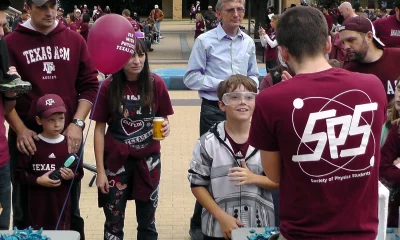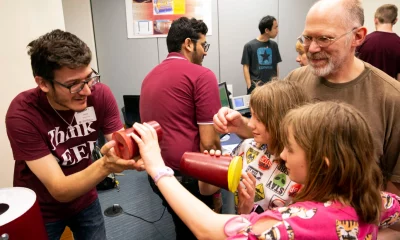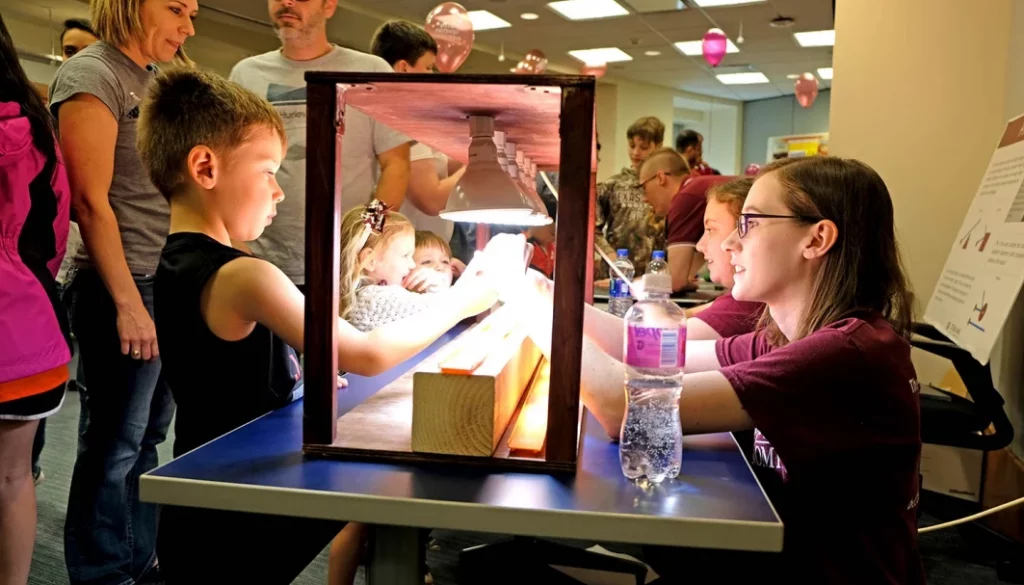Texas A&M Study Finds Physics Outreach Participation Benefits Scientific Identity, Student Career Prospects
Although educational outreach programs sometimes get short shrift in academic circles in terms of prioritizing, funding and staffing, a new Texas A&M University study indicates they are a solid investment with benefits far beyond the institutional bottom line when it comes to physics.
Physicists and learning scientists at Texas A&M and the University of Texas at Austin spent roughly two years surveying and interviewing more than 100 undergraduate and graduate students involved in presenting multiple physics outreach programs at Texas A&M. In the team’s final analysis, published last month in the American Physical Society (APS) journal Physical Review Physics Education Research, they determined that students gain as much from their experiences as their audiences do, namely positive effects on their identities as science professionals that can offer invaluable insight into their persistence and retention in STEM, not to mention their preparation for 21st century careers in science and other areas.

“Though often considered a low priority public service, university-based physics outreach programs increasingly are being recognized for the direct positive impact they have, not only on audiences and attendees, but also on the students facilitating them,” said Texas A&M physicist and Presidential Professor for Teaching Excellence Tatiana Erukhimova, corresponding author of the study, which was based on self-reported data previously presented in preliminary form at the APS March Meeting 2021. “The idea that outreach programs are beneficial only for school children or members of the public is misguided, because it misses a potential transformational educational experience of the university students directly involved in presenting these programs.”
The study, the largest of its kind to date, determined through a combination of completed surveys and follow-up interviews that students experienced an overwhelmingly positive effect on their physics identity, became more confident in their scientific abilities, increased their sense of belonging to the physics community, and developed communication, teamwork, networking and design skills as a result of helping to facilitate one or more outreach programs during their time at Texas A&M.
“The transition from novice to physicist is a lengthy and complex process guided by both formal and informal experiences,” Erukhimova said. “For many, this is a journey that begins with a movement toward becoming a physicist, but subsequently turns in other directions. In this work, we observed how participation in informal physics programs can support an individual in becoming a physicist and boost their development through less-structured but critically-important experiential learning.”

The study authors note that involvement in educational outreach can provide rich teaching opportunities for students, bringing physics beyond the pages of a textbook and challenging them to break down concepts, which potentially promotes a deeper understanding. In addition, physics outreach programs can provide pathways to enhanced confidence through experiential contexts beyond classrooms and laboratories. By facilitating outreach, students foster skills that promote career readiness, from communication, teamwork, networking and design skills, to an increased conceptual understanding of physics.
“Our results add to the growing understanding of how informal physics, or outreach, programs provide a platform for broader interactions between individual students and the STEM community and equip university students with the skills needed for the 21st century careers,” Erukhimova added. “The data may help physics departments across the country design the out-of-classroom experiences of their students in a way that would improve their persistence and retention within STEM disciplines and better prepare them for 21st century careers in science and beyond.”
In addition to Erukhimova, the team featured 2020 Texas A&M physics graduate and first author Callie A. Rethman ’20, who is now teaching physics in the Cypress-Fairbanks Independent School District; University of Texas physicist Jonathan Perry, a 2018 Texas A&M physics Ph.D. graduate and former Texas A&M physicist; Texas A&M Center for Teaching Excellence Postdoctoral Research Associate Jonan Donaldson; and 2020 Texas A&M master’s in educational psychology graduate Daniel Y. Choi ’20, who is currently pursuing his doctorate in the same area and also is affiliated with the CTE.
“Supporting outreach programs not only fulfills the service mission of our public university, but also a critical part of our educational mission by helping participating students build their professional identity and develop important career skills,” Erukhimova said.
The team’s research was funded in part by the College of Science Diversity and Equity Small Grants Program. Their paper, “Impact of informal physics programs on university student development: Creating a physicist,” can be viewed online along with related figures and citations.
“We would like to thank all students who participated in the survey and interviews,” Erukhimova said. “We would also like to thank the many wonderful students, faculty, staff and donors who make our outreach programs possible.”
Learn more about educational outreach programs in the Texas A&M Department of Physics and Astronomy.
# # # # # # # # # #
About Research at Texas A&M University: As one of the world’s leading research institutions, Texas A&M is at the forefront in making significant contributions to scholarship and discovery, including science and technology. Research conducted at Texas A&M generated annual expenditures of more than $1.131 billion in fiscal year 2020. Texas A&M ranked in the top 25 of the most recent National Science Foundation Higher Education Research and Development survey based on expenditures of more than $952 million in fiscal year 2019. Texas A&M’s research creates new knowledge that provides basic, fundamental, and applied contributions resulting in economic benefits to the state, nation, and world. To learn more, visit Research@Texas A&M.
-aTm-
Contact: Shana K. Hutchins, (979) 862-1237 or shutchins@science.tamu.edu or Dr. Tatiana Erukhimova, (979) 845-5644 or etanya@physics.tamu.edu
The post Texas A&M Study Finds Physics Outreach Participation Benefits Scientific Identity, Student Career Prospects appeared first on Texas A&M College of Science.
